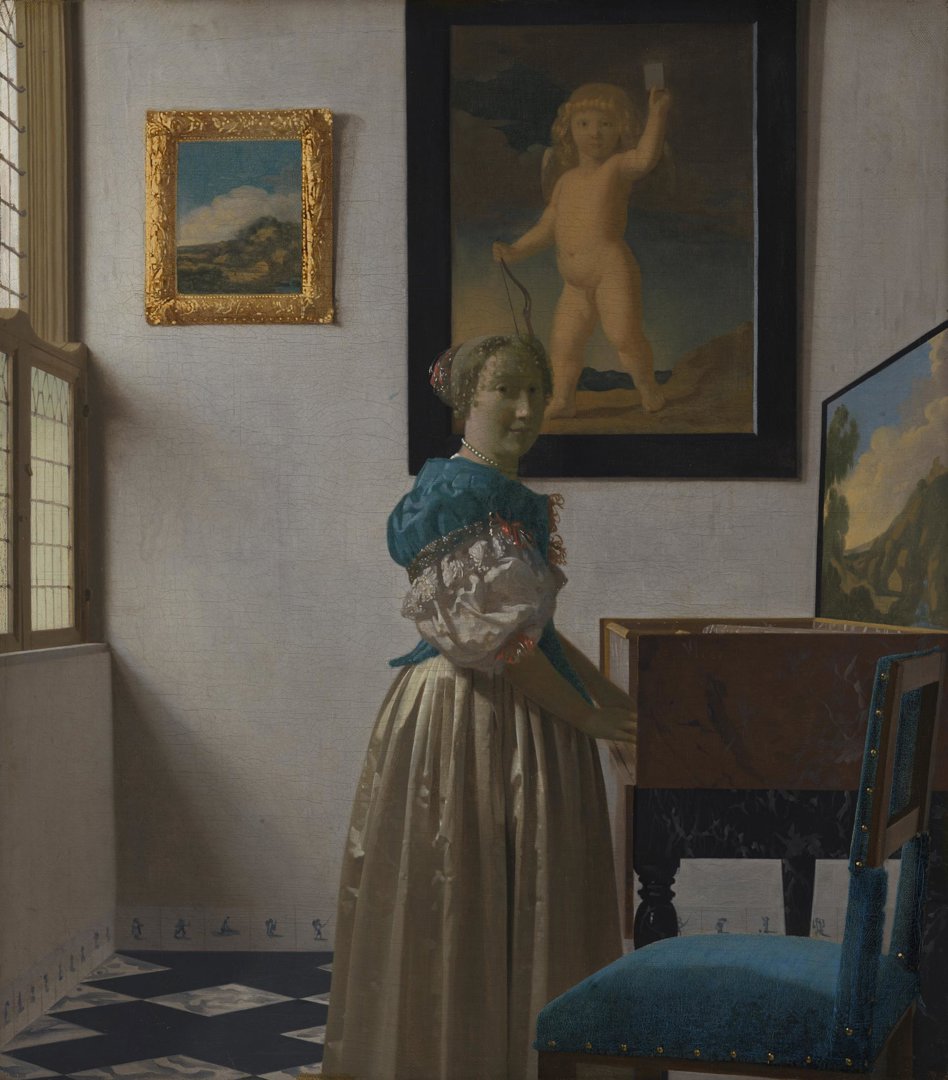Vermeer’s 'A Young Woman standing at a Virginal'
Audio description
This is a description of a detailed oil painting called A Young Woman standing at a Virginal, by the Dutch artist Johannes Vermeer. The work is small, about half a meter square, and was created between 1670 and 1672. The image features a well-dressed young woman in a nicely decorated room. She’s standing at a virginal: a musical instrument that resembles a piano, or harpsichord. The woman takes center stage in the painting, her graceful posture commanding our attention. She stands facing her instrument which is on the right, her delicate hands resting on the keys in front of her, while her head turns toward us with a modest smile. She has a pale, rounded face and dark brown eyes that gaze directly at the viewer. She wears a bell-shaped, floor-length skirt made of pale-yellow silk, with each fold carefully delineated, capturing the way light and shadow play upon the delicate material. Her top made of blue taffeta is richly decorated with reddish pink ribbons and pearls. Billowing white sleeves complete her ensemble, leaving her forearms exposed. Her hair is worn in the style of the time, tucked up into a small red and grey bonnet at the back, her blond curls and forehead partly covered by a lace veil. She wears a pearl necklace. The room she is standing in is painted white and has a bright, airy feel. The image is cropped, revealing part of the rear wall and a glimpse of the wall on the far left. This wall has several large, lead-paned windows in it, letting soft light flood the painting. The floor is paved in bold dark blue and white tiles: the darker tiles forming cross shapes. The floor is enclosed by a row of white delft tiles featuring intricate patterns where a skirting board would typically be. Hanging on the rear wall there are two paintings. On the left is a small, traditional landscape rendered in green, blue, and white tones. It has a gilded frame that reflects the light, outshining the picture inside it. To the right is a much larger painting in a dark, matte wooden frame. This painting is intentionally symbolic: it depicts a naked baby, with blond hair, and wings. This is Cupid, God of love, holding a bow in his right hand and a playing card in his left. The card is raised above his head as if trying to catch our attention. The card contains the motto: ’Only one’. In the foreground, on the right, the wooden lid of the virginal is open, revealing a painted landscape beneath a blue, cloudy sky. Positioned nearby is a simple wooden-framed chair, slightly angled away from us and ready for someone to sit and listen to the music. The chair is covered in rich dark blue velvet with golden studs, shimmering in the light streaming from the window. What distinguishes Vermeer's work from that of his contemporaries is his mastery of light. With it, he creates an atmosphere that enhances the narrative within the painting. This is beautifully demonstrated here: not only with the clarity of daylight streaming in through the window, but also in Vermeer’s skill in the subtle effects of light on objects in the room. This interplay reveals volume, casts delicate shadows, and defines the spatial relationships. The fine silks, glistening pearls, the golden frame, the opulent velvet upholstery indicate the young woman's affluence. Symbolic hints, such as Cupid's motto, the vacant chair, and her inviting smile, suggest she anticipates a particular kind of love—idealised and virtuous. As visitors to this scene, we stand just outside the frame, invited into her world.


